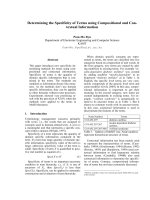Learning Bitcoin - Embrace the new world of finance by leveragin the power of crypto-currencies using Bitcoin and the Blockchain
Bạn đang xem bản rút gọn của tài liệu. Xem và tải ngay bản đầy đủ của tài liệu tại đây (7.78 MB, 236 trang )
Learning Bitcoin
Embrace the new world of fiance by leveraging
the power of crypto-currencies using Bitcoin and
the Blockchain
Richard Caetano
BIRMINGHAM - MUMBAI
Learning Bitcoin
Copyright © 2015 Packt Publishing
All rights reserved. No part of this book may be reproduced, stored in a retrieval
system, or transmitted in any form or by any means, without the prior written
permission of the publisher, except in the case of brief quotations embedded in
critical articles or reviews.
Every effort has been made in the preparation of this book to ensure the accuracy
of the information presented. However, the information contained in this book is
sold without warranty, either express or implied. Neither the author, nor Packt
Publishing, and its dealers and distributors will be held liable for any damages
caused or alleged to be caused directly or indirectly by this book.
Packt Publishing has endeavored to provide trademark information about all of the
companies and products mentioned in this book by the appropriate use of capitals.
However, Packt Publishing cannot guarantee the accuracy of this information.
First published: November 2015
Production reference: 1271015
Published by Packt Publishing Ltd.
Livery Place
35 Livery Street
Birmingham B3 2PB, UK.
ISBN 978-1-78528-730-5
www.packtpub.com
Credits
Author
Richard Caetano
Reviewers
Francesco Canessa
Project Coordinator
Harshal Ved
Proofreader
Safis Editing
Jose Celano
Indexer
Commissioning Editor
Rekha Nair
Edward Bowkett
Production Coordinator
Acquisition Editor
Aparna Bhagat
Tushar Gupta
Cover Work
Content Development Editor
Dharmesh Parmar
Technical Editor
Namrata Patil
Copy Editor
Alpha Singh
Aparna Bhagat
About the Author
Richard Caetano is an entrepreneur and software developer living in Paris,
France, and was originally raised on a dairy farm in the middle of California. He
discovered a strong interest in software development at an early age. Over the
years, he has designed and developed systems ranging from agriculture process
automation and government accounting to high-tech security, digital music, and
mobile video games.
In 2011, Richard found the Bitcoin whitepaper and experienced a paradigm shift.
After realizing the potential of this new technology, he changed course, and since
then has been evangelizing this powerful new technology to the world.
He launched an early application called btcReport, which leverages good design to
bring news and information to those interested in Bitcoin. Since then, he has been
speaking at conferences and meetings to help spread the word about Bitcoin.
In 2015, he launched Stratumn, a company focused on helping developers build
transparent, easy-to-audit, and secure applications by using the blockchain,
the technology that powers the Bitcoin currency.
Acknowledgments
I would like to first thank Tyler Love, a close friend from my hometown in
California. I clearly remember the day, back in early 2011, when he sent me an
instant message about Bitcoin. It has been an amazing journey since that day,
and has been ever so rewarding.
I'm very thankful to my good friends at Epicenter Bitcoin, Sebastien Couture and
Brian Fabian Crain, as they were the ones who introduced me to the publisher of
Learning Bitcoin. In addition, I would like to thank all my friends in and around
the Bitcoin space.
The editorial staff at Packt Publishing has been very supportive and helpful in
making this book project a reality. I would like to thank Tushar Gupta for getting me
into the right headspace to write, Natasha DSouza for her encouragement, Dharmesh
Parmar for his guidance towards delivery, and Namrata Patil for her attention to the
editorial details. I especially would like to thank the technical reviewers of the book:
Francesco Canessa, Jose Celano, and John Jegutanis.
I have all my family and friends from my childhood on the farm to thank for all the
opportunities I have had in life. I am thankful for my father's patience as he taught
me electronics, and my mother's support as she took me to Radio Shack countless
times to purchase packets of transistors and diodes. Ultimately, it was the TRS-80
computer that they gave me that set the course for my life.
I would like to mention Atelier Meraki located in my neighborhood in Paris. While
writing this book, I spent many late nights working there. The word "Meraki" in Greek
means to put your love, soul, and creativity into your work. That motto has been
an inspiration for this project. I would like to thank Sherif Sy and Marie-Charlotte
Moreau for all their hard work in making the space a wonderful place to work.
I would like to thank my Buddhist teachers and friends for helping me work with the
best state of mind. More and more, I find that happiness comes from the simplest of
lessons. Thank you.
Mais surtout, je tiens à remercier mon épouse Cécile pour toute son aide et son
soutien alors que j'ai sauté la tête la première dans le Bitcoin. À l'époque, cela pouvait
sembler une idée folle mais elle m'a toujours été derrière moi. C'est grâce
à elle que j'ai écrit ce livre.
About the Reviewers
Francesco Canessa is a software developer experienced in Bitcoin and blockchain
technologies. His preferred tools when working with Bitcoin are Bitcoin Core via
its JSON API for its solidity and simplicity, and the Bitcore JavaScript library for
making slim client-side wallet software. As he believes that Bitcoin and blockchain
are important innovations of our times, he builds open source projects (for example,
BitNFC—) to research and show the true power of these new
technologies, and find new ways to drive Bitcoin's adoption. He has been working as
the main translator on the Italian edition of Mastering Bitcoin, O'Reilly Media, written
by Andreas M. Antonopoulous. His favorite programming language is Ruby and his
hobbies are creating 3D printers and IoT.
Jose Celano started with computers when he was 10 and was given a Commodore
64. Jose holds a bachelor's degree in technical engineering in computer systems from
the University of Las Palmas de Gran Canaria. He set up an IT company in 2004
after he finished his studies (iQ ingenieros), where he worked for 10 years, mainly
developing web applications. He has always been interested in Internet payment
systems and web development.
In September 2013, he began to investigate Bitcoin. In February 2014, he become
a freelancer and started working on Bitcoin projects. Recently, Jose has worked
as a private PHP consultant for BlockCypher, a San Francisco start-up providing
blockchain web services to enable developers to easily build reliable blockchain
applications.
www.PacktPub.com
Support files, eBooks, discount offers, and more
For support files and downloads related to your book, please visit www.PacktPub.com.
Did you know that Packt offers eBook versions of every book published, with PDF
and ePub files available? You can upgrade to the eBook version at www.PacktPub.
com and as a print book customer, you are entitled to a discount on the eBook copy.
Get in touch with us at for more details.
At www.PacktPub.com, you can also read a collection of free technical articles, sign
up for a range of free newsletters and receive exclusive discounts and offers on Packt
books and eBooks.
TM
/>
Do you need instant solutions to your IT questions? PacktLib is Packt's online digital
book library. Here, you can search, access, and read Packt's entire library of books.
Why subscribe?
• Fully searchable across every book published by Packt
• Copy and paste, print, and bookmark content
• On demand and accessible via a web browser
Free access for Packt account holders
If you have an account with Packt at www.PacktPub.com, you can use this to access
PacktLib today and view 9 entirely free books. Simply use your login credentials for
immediate access.
Table of Contents
Prefacevii
Chapter 1: Setting up a Wallet
1
A brief history of money
Buying your first bitcoin in 15 minutes
Signing up for a wallet – five minutes
Adding a funding source – ten minutes
Buying bitcoin – less than a minute
Looking at your Bitcoin balance
Explaining Bitcoin addresses
Sending and receiving bitcoins
Sending bitcoins
Receiving bitcoins
Private keys and wallets
Transactions and confirmations
Transactions
Confirmations
Comparing Bitcoin wallets
Online wallets
Desktop wallets
Mobile wallets
Hardware wallets
Summary
Chapter 2: Buying and Selling Bitcoins
Understanding Bitcoin's price volatility
Exchange rates
Bitcoin's price history
Price bubbles
[i]
2
2
4
5
6
7
9
10
11
14
15
17
17
20
21
21
22
23
24
25
27
27
28
29
29
Table of Contents
Theft
Seizure
Following exchange rates and news
Price tickers
Detailed price tracking
Candlestick charts
Market orders
Trading techniques
News sources
Comparing Bitcoin exchanges
Volume and liquidity
Fees and commissions
Transfer limits
Jurisdiction and regulations
Service uptime
Trading Bitcoins on an exchange
Setting up an account
Depositing funds
Using Coinbase Exchange
30
31
32
32
34
35
36
36
38
40
40
41
42
42
43
43
44
45
46
Physical Bitcoins
Summary
48
50
Funding and orders
Order book and history
Price charts
Chapter 3: Protecting Your Bitcoins
Storing your bitcoins
Bitcoin savings
Paper wallets
One time use paper wallets
Creating a paper wallet
Verifying your wallet's balance
Importing versus sweeping
Importing your paper wallet
Paper wallet guidelines
Paper wallet services
47
47
47
51
52
53
53
54
55
56
58
59
59
60
Brainwallets
61
Increasing brainwallet security
63
Installing a HD wallet
Bitcoins in cold storage
70
71
Creating a brainwallet
61
Deterministic wallets
Type 2 Hierarchical Deterministic wallets
65
68
Cold storage with Electrum
72
[ ii ]
Table of Contents
Verifying access to a private key
Good housekeeping with Bitcoin
Summary
Chapter 4: Understanding the Blockchain
The Genesis block
Satoshi Nakamoto
The whitepaper
The blockchain
Keys, transactions, and blocks
Creating a transaction
Digital signatures
Public key encryption
Signing a document
Elliptic Curve Cryptography
Bitcoin addresses
Cryptographic hashes
Generating a Bitcoin address
74
75
76
77
77
78
79
80
80
80
83
83
84
85
85
86
87
Signing a transaction
89
Decentralized network
90
Broadcasting the transaction
91
The blockchain
91
Blocks
92
Forks
93
The Bitcoin supply
95
Proof of work
96
Confirmation
96
Difficulty level
97
Mining
97
Solving a difficult problem
98
Transaction fees
99
Network attacks
100
51 percent attacks
100
Race attacks
100
Finney attacks
101
Alternative coins
101
Summary102
Chapter 5: Installing a Bitcoin Node
Understanding a Bitcoin node
Bitcoin Core
[ iii ]
103
103
104
Table of Contents
Internals of a node
105
Node discovery
Messaging
Maintaining a Blockchain
Transaction relaying
Bitcoin wallets
105
106
106
106
107
Installing the client
Requirements
Starting the client
Connecting to the network
Downloading the blockchain
Using the client
Encrypting your wallet
Backing up your wallet
Balance and history
107
108
109
109
110
110
111
111
112
Sending transactions
Executing Bitcoin operations
Opening the console
Working with an encrypted wallet
Working with Bitcoin addresses
Creating and sending a transaction
114
115
116
117
118
120
Summary
126
Receiving transactions
Generating a destination address
Selecting a funding source
Specifying a change address
Including a transaction fee
Defining the transaction in JSON
Encoding and signing the transaction
Reviewing the transaction
Broadcasting the transaction
Chapter 6: Understanding the Mining Process
Digital gold
Bitcoin mining
Exploring the mining ecosystem
Validating transactions
Proof-of-Work
SHA-256
Scrypt
112
121
121
122
122
122
123
124
125
127
128
128
129
130
131
131
133
Mining rewards
Difficulty metrics
Mining hardware
133
133
135
[ iv ]
Table of Contents
Mining conditions
Mining pools
136
137
Mining shares
Fees and Payout
137
137
Cloud mining
Estimating profitability
138
138
Setting up a mining client
Requirements
142
142
Choosing the equipment
Choosing the software
Connecting to a mining pool
The payout method
The pool fees
The pool speed
Additional features
Avoiding large pools
Running the client
Summary
144
145
145
145
146
146
146
147
147
148
Hardware efficiency
Factoring in the difficulty level
Selecting a currency
Exchange rates
139
139
140
141
Capital
Hardware
Facilities
142
142
143
Chapter 7: Programming Bitcoin
149
Programmable money
Decentralized applications
Blockchains
150
151
151
Public Blockchains
Permissioned Blockchains
Smart contracts
Installing BitcoinJS
Requirements
Beginning the installation
Editing the source code
Programming common Bitcoin operations
Checking your balance
Generating addresses for a website
Sending transactions
Simple transactions
[v]
152
152
152
153
154
154
155
156
158
161
161
162
Table of Contents
Building an Escrow contract
Generating the keys
Generating the Escrow address
Creating a withdraw script
Signing the transaction
Broadcasting the transaction
Refunding
Summary
Chapter 8: Exploring Alternative Coins
Open source money
The rise of the alt-coin
Namecoin
Decentralized domain name service
Merged mining
Litecoin
Block rate
Scrypt mining
Peercoin
Proof-of-stake
Primecoin
Prime numbers
Mining prime numbers
Evaluating an alt-coin
Developer activity
Launching of the alt-coin
The legitimate feature set
165
167
169
171
173
176
177
177
179
180
180
181
181
182
184
184
185
186
186
187
187
188
188
189
189
190
Protocols built on the Bitcoin Blockchain
Digital assets
Building a voting system with Counterparty
The XCP alt-coin
Creating a voting system
Creating a wallet
Funding the wallet
Creating the tokens
Sending tokens
190
190
191
191
192
193
196
198
199
Verifying the results
Finishing up
The future of finance
201
202
203
Casting votes
Index
201
205
[ vi ]
Preface
Bitcoin is truly a new kind of money. As an open network of computers, it exists
purely on the Internet. Anyone with access to the Internet can send and receive
money as easily as sending an e-mail. With this new form of digital cash, we are
seeing the beginning of a new world of finance.
Bitcoin was launched in January 2009, just a few months after the financial crisis
of 2008. As a true peer-to-peer currency, anyone in the world has access to bitcoin,
with the ability to send it to anyone else. Its design insures that nobody can have
their funds locked or taken away. The effects of this breakthrough currency are quite
impressive. We have already seen the currency rise in price from less than one US
cent to over a thousand dollars.
Since its launch, Bitcoin has challenged the mainstream view of finance. Originally
designed as Digital Gold, Bitcoin's scarce supply and resistance to manipulation
has resulted in an explosion of new ideas and projects with the strong potential to
disrupt major industries and revolutionize finance.
Its anonymous creator, Satoshi Nakamoto, is only known through his contributions,
namely the Bitcoin whitepaper and his initial forum posts to help guide core
developers to support and maintain the source code. While nobody can confirm his
identity, the value of his work is evident in the fact that the Bitcoin source code has
been tested and challenged without any serious bugs or exploits reported. This is
truly an amazing feat.
In this book, we will introduce Bitcoin with a hands-on approach. We will begin
with a simple and easy-to-follow introduction, which includes buying and selling
bitcoin. Throughout the middle, we will look into the internal workings of Bitcoin
to understand how its various pieces work. Towards the end, we will explore
various ways in which Bitcoin can be used as "programmable money".
[ vii ]
Preface
What this book covers
Chapter 1, Setting Up a Wallet, introduces the reader to Bitcoin and how to purchase
some within 15 minutes. It covers the basics of Bitcoin, which includes addresses,
keys, and wallets.
Chapter 2, Buying and Selling Bitcoins, covers more advanced ways of buying and
selling bitcoin. Market trading and the tools involved are introduced.
Chapter 3, Protecting Your Bitcoins, educates you about how to become your own bank.
Different approaches to safeguarding bitcoin are introduced and discussed.
Chapter 4, Understanding the Blockchain, gets into the nuts and bolts of Bitcoin's
underlying technology. Its various technologies and algorithms are illustrated
and explained.
Chapter 5, Installing a Bitcoin Node, is a step-by-step tutorial on setting up
a Bitcoin node, which allows you to participate in the network. Some basic
Bitcoin programming is introduced.
Chapter 6, Understanding the Mining Process, guides you through the various options
available for mining bitcoin. The chapter focuses on the expenses involved and
helps you to evaluate profitability.
Chapter 7, Programming Bitcoin, dives into the potential of Bitcoin as "programmable
money". The chapter describes an example of how to build a simple Bitcoin escrow
service using JavaScript.
Chapter 8, Exploring Alternative Coins, takes a tour around four innovative alternative
coins based on Bitcoin's original source code. It ends with an example of how to set
up a voting ballot secured by cryptographic proof.
What you need for this book
To follow along with the examples of this book, you will need a modern web
browser and a stable internet connection. Many of the Bitcoin services mentioned
in the book are web-based and will only work on modern equipment. An iOS or
Android smartphone might be necessary for some operations and authentication.
To be able to set up and install a Bitcoin node, a fast internet connection and
a computer with a strong processor is required. The hard drive should have a
minimum storage of 50 GB available, but more will be needed as the blockchain
grows in size.
[ viii ]
Preface
For the various aspects that involve programming, a computer with access to a
terminal is required. Mac OS/X, Windows, and Linux have console access within
a terminal. There are some additional tools required for setting up, such as Node.js,
in order to follow along with the examples. Lists of the tools are provided with
the examples.
If you are interested in setting up a Bitcoin mining rig, special equipment is required.
Some of the equipment might be difficult to find and expensive to purchase. As the
market is still new, one can expect many changes in pricing and availability. It is
recommended that you check the forums and online marketplaces, such as eBay
and Craigslist, to find more information about purchasing the equipment.
Who this book is for
This book is written to help introduce Bitcoin to anyone who has basic experience
with online banking. Most of the first half of the book is written for those who are
very new to digital finance.
The second half of the book is written for those who are interested in seeing Bitcoin's
potential. You do not have to be a programmer or hardware engineer to follow
along, as simple explanations with clear illustrations are provided.
For more technical readers, scripts and installation notes are provided to help
develop a deeper understanding of Bitcoin.
Conventions
In this book, you will find a number of text styles that distinguish between different
kinds of information. Here are some examples of these styles, and explanations of
their meanings.
Code words in text, database table names, folder names, filenames, file extensions,
pathnames, dummy URLs, user input, and Twitter handles are shown as follows:
"We can include other contexts through the use of the include directive."
A block of code is set as follows:
// convert 'satoshi' to bitcoin value
var satoshiToBTC = function(value) {
return value * 0.00000001
}
[ ix ]
Preface
Any command-line input or output is written as follows:
~ npm install bitcoinjs-lib -g
New terms and important words are shown in bold. Words that you see on
the screen, for example, in menus or dialog boxes, appear in the text like this:
"Clicking the Next button moves you to the next screen."
Warnings or important notes appear in a box like this.
Tips and tricks appear like this.
Reader feedback
Feedback from our readers is always welcome. Let us know what you think about
this book—what you liked or disliked. Reader feedback is important for us as it
helps us develop titles that you will really get the most out of.
To send us general feedback, simply e-mail , and mention
the book's title in the subject of your message.
If there is a topic that you have expertise in and you are interested in either writing
or contributing to a book, see our author guide at www.packtpub.com/authors.
Customer support
Now that you are the proud owner of a Packt book, we have a number of things
to help you to get the most from your purchase.
Downloading the example code
You can download the example code files from your account at http://www.
packtpub.com for all the Packt Publishing books you have purchased. If you
purchased this book elsewhere, you can visit />and register to have the files e-mailed directly to you.
[x]
Preface
Errata
Although we have taken every care to ensure the accuracy of our content, mistakes
do happen. If you find a mistake in one of our books—maybe a mistake in the text or
the code—we would be grateful if you could report this to us. By doing so, you can
save other readers from frustration and help us improve subsequent versions of this
book. If you find any errata, please report them by visiting ktpub.
com/submit-errata, selecting your book, clicking on the Errata Submission Form
link, and entering the details of your errata. Once your errata are verified, your
submission will be accepted and the errata will be uploaded to our website or
added to any list of existing errata under the Errata section of that title.
To view the previously submitted errata, go to />content/support and enter the name of the book in the search field. The required
information will appear under the Errata section.
Piracy
Piracy of copyrighted material on the Internet is an ongoing problem across all
media. At Packt, we take the protection of our copyright and licenses very seriously.
If you come across any illegal copies of our works in any form on the Internet, please
provide us with the location address or website name immediately so that we can
pursue a remedy.
Please contact us at with a link to the suspected
pirated material.
We appreciate your help in protecting our authors and our ability to bring you
valuable content.
Questions
If you have a problem with any aspect of this book, you can contact us at
, and we will do our best to address the problem.
[ xi ]
Setting up a Wallet
"When bitcoin currency is converted from currency into cash, that interface has to
remain under some regulatory safeguards. I think the fact that within the bitcoin
universe an algorithm replaces the functions of the government …[that] is actually
pretty cool."
– Al Gore, former Vice President of the United States
Bitcoin's potential is quickly becoming apparent in the rapidly changing world
of Internet finance. In just the few short years since its launch, we have seen an
explosion of interest in this new, and somewhat mysterious, Internet money. Yet,
several questions quickly come to mind: How does it work? Where does it come
from? How do I buy it?
In this chapter, we will illustrate, in simple terms, most of what anyone new to
Bitcoin will need to know to start. We will start by covering the following core topics:
• Buying your first bitcoin, in 15 minutes
• Explaining Bitcoin addresses
• Sending and receiving
• Private keys and wallets
• Transactions and confirmations
• Comparing Bitcoin wallets
[1]
Setting up a Wallet
A brief history of money
Humans have been trading various forms of money for thousands of years. Many
types of precious objects, acting as a Medium of Exchange, have been used. In the early
ages, we traded grain, cattle, shells, and gems for other goods and services. This type
of money, which we can touch and see, can be considered Physical Money.
As civilization progressed, so did our political systems. Eventually, sparse tribes
and villages consolidated into kingdoms, states, and empires. Through the
transformation, we saw our money shift into Political Money; money that's governed
and issued by a central body such as the King, Emperor or, as in today's society, a
Central Bank. State issued coins, bills, and notes, as well as taxation, regulation, and
monetary policy—all emerged from this shift.
Today, Internet technology connects us directly to each other, opening a vast range
of possibilities. By dissolving pre-existing physical and political boundaries, for the
first time in history, the entire planet has access to the same information. This level
of access is guaranteed by the Internet's decentralized design. Without a centralized
hub, there is no single point of failure or control.
Satoshi Nakamoto, the creator of Bitcoin, leveraged this powerful network to
implement a peer-to-peer (P2P) system for exchanging virtual cash. Built on a
decentralized design and protected by powerful cryptography, this new type of
money is no longer physical, yet resilient against corruption and manipulation.
No single group of individuals, including governments, banks, and corporations,
control Bitcoin because all the peers are equal actors, participating through the same
protocol. Its monetary policy is defined and self-regulated by its open network of
computers. Thus, with Bitcoin we're seeing the emergence of a new phase of money.
This P2P money is called cryptographic money or simply Crypto-Currency.
We're going to start exploring the world of Bitcoin by purchasing a small amount.
Buying your first bitcoin in 15 minutes
Buying bitcoin is similar to buying foreign currencies. When an American lands in
Paris, the fist thing he/she may need to do is exchange dollars for Euros. While at
the airport, it's likely he/she will be able to fid a currency exchange to help. Just as
there are many exchanges for exchanging government currencies, there are many
exchanges for exchanging bitcoins.
[2]
Chapter 1
Today there are markets for exchanging bitcoin with most of the world's major
currencies. Most of them are online markets through which you can connect your
bank account or credit card. There are some markets where the buyer and seller meet
in person to exchange by hand. For the more technical users, private markets exist
on chat forums where anonymous users trade with the other users based on their
online reputation.
Of all the diverse ways to buy bitcoin, using a reputable online exchange may be
the likely option for most users. Online exchanges generally operate similar to
conventional online banking systems and are easy to set up.
We're going to buy 25 dollars worth of bitcoin using a credit card with an online
exchange called Circle. In 2013, Circle was launched by a team competent in
technology and finance. Additionally, they are registered as a money transmitter with
FinCEN, a US government agency responsible for safeguarding the financial system
from illicit use. For US citizens, they offer an instant exchange with a user-friendly
wallet service. To buy bitcoins with Circle, you'll need the following:
• Valid photo ID
• A US home or business address
• A US bank account or credit card
• An iOS or Android smartphone
• 15 Minutes of free time
Buying and selling bitcoin on Circle is only available to users with a US address. As a
registered money transmitter, Circle must follow standard banking practices such as
Know your customer (KYC) and anti-money laundering laws (AML). These are the
requirements to accept bank transfers from the US banking system.
Most European and Canadian customers can use Coinbase ()
for direct wire transfers. We'll discuss buying and selling with Coinbase later
in Chapter 2, Buying and Selling Bitcoins.
What's important to remember about Bitcoin is that the currency exists
independently of any government's requirement for an individual's identity. Bitcoins
can be exchanged with cash, hand-to-hand, thus by passing the registration process
that we will describe in this chapter.
There are services such as Local Bitcoins () where
the users can buy and sell Bitcoin through direct exchange with the other users.
While it is generally safe to do so, some users may be at risk from local regulations.
It is important to research the local currency laws before transacting through these
services, especially with large amount of cash.
[3]
Setting up a Wallet
Signing up for a wallet – five minutes
To begin the signup process, open in your web browser and
follow the SIGN UP links. You will be prompted to enter your First Name, your
name, your Email address, and a password. After submitting your details, Circle will
send you an e-mail verification. Simply follow the instructions provided. If you don't
receive the email, check the spam folder of the email address you provided.
After verifying your email address, you'll be asked to enable two-factor authentication
using your mobile phone. This security system uses a code sent via SMS or through
Google Authenticator to allow access to your account and confirm irreversible
actions, such as sending bitcoin. This helps make your account more secure by
combining your password with something you physically hold, that is, your phone.
Finally, Circle will prompt you to provide two security questions. In case you lose
your password, these questions will be asked before you can reset it.
Figure 1.1 - Sign up with Circle to purchase bitcoin
[4]









